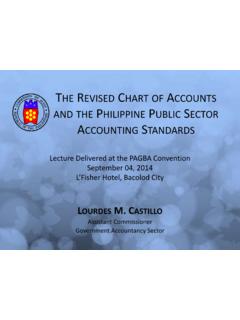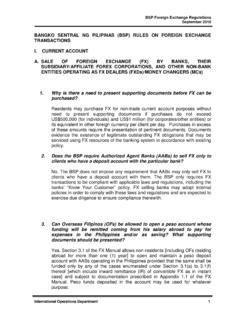Transcription of New Wind Load Provisions in Philippine Structural Code
1 New Wind load Provisions in Philippine Structural code William T. Tanzo Vice-President, Vibrametrics Inc., Philippines Benito M. Pacheco President, Vibrametrics Inc., Philippines New National Structural code A new edition of the Structural code , the Fifth Edition of the National Structural code of the Philippines (hereinafter NSCP2001), was completed in 2001, almost ten years since the previous code edition. This replaces the previous edition which was the Fourth Edition of the National Structural code of the Philippines (hereinafter NSCP1992) which was adopted in 1992. NSCP2001 was approved and endorsed by the Professional Regulation Commission in November 2002, and was approved as a referral code of the National Building code of the Philippines in June 2003. At present, it is widely adopted in use by the Philippine Structural engineering community.
2 NSCP2001 is considered a major code revision with changes in different aspects of Structural design. The wind load code Provisions are no exception to this major revision. Among the major changes are the adoption of the 3-second gust speed in place of the long been-used fastest kilometer wind speed, accounting for topographic effects, accounting for torsional effect in low-rise building. Structural design codes are historically tied to follow practices, and the tie still extends to the presently adopted edition. NSCP92 wind load Provisions are essentially based on the Provisions of the 1988 Uniform Building code (hereinafter UBC1988), which was in turn basically based on the ANSI Historically, the wind loading concepts could be traced back to those introduced in the 1972 ANSI.
3 In the Philippine situation, the National Building code of the Philippines Technical Committee makes a review of the existing code about four to five years after every code adoption. Provisions on seismic loading and wind loading were reviewed and actively discussed by the Building code Committee on Lateral Loads probably around 1997 with the release of the 1997 Uniform Building code in the and ASCE 7-1995. Major Changes in Wind load Provisions A major change in the wind load provision of the new Structural code is the adoption of the 3-second gust speed in place of the long been-used fastest kilometer wind speed. The wind map presented in the current code is based on the wind speed data from the Philippine Atmospheric, Geophysical and Astronomical Services Administration (PAGASA).
4 The data covers 50 weather stations located nationwide and comprise of about 30 years of record. The map represents 3-sec gust wind speeds with annual probability of exceedance of (or 50-year return period). The whole of the Philippines is divided into three major wind zones namely: high wind zone, mid-wind zone, and low-wind zone. Zone I which is the high wind zone has basic wind speed of 250 kilometers per hour (kph). This covers mainly the eastern portion of Luzon and Visayas which is frequently visited by typhoons. Zone II, the mid-wind zone, has basic wind speed of 200 kph. This covers the rest of Luzon and Visayas. Zone III, the low-wind zone with basic wind speed of 125 kph, covers Palawan and the rest of Mindanao. A formula for calculating the velocity pressure is based on the basic wind speed, a velocity pressure exposure coefficient, a topographic factor, and an importance factor.
5 The velocity pressure exposure coefficients are tabulated given values that accounts for the variation of wind speed with height above ground and with ground surface roughness as defined using exposure category. Four exposure categories are defined to best describe the surface roughness that could affect wind exposure as affected by natural environmental features such as topography and vegetation, as well as the effect of built-up environment. Provision for topographic effect is newly added to account for wind speed-up over isolated hills and escarpments. The topographic factor is dependent on three multipliers based on topographical dimensions. The present provision is limited to isolated two-dimensional ridges, escarpments and axisymmetric hills. Torsional effect is also a new feature of the code by providing for full and partial loading on main wind resisting system of buildings with a mean roof height greater than 18 meters.
6 Four loading cases as indicated need to be checked and evaluated. The loading combinations in these loading cases include full loading perpendicular to each principal axis, partial loading on two faces simultaneously, and partial loadings to induce torsional moments about the vertical axis. APEC Workshops on Wind Engineering During this period when active efforts were being conducted for the proposed revision of the NSCP1992, engineers from the Philippines participated in an informal network of engineers from APEC member-economies in a series of regional workshops on international alignment of loading starting in 1996. The many ideas and discussions during the workshops were echoed back to the Philippine wind engineering community through presentations in the annual and midyear conventions of civil engineers.
7 While the wind load Provisions in the NSCP2001 is still, by and large, a development based on our code tradition of adopting from the design code practices, future Philippine wind engineering design code practices will surely benefit from the continuing efforts of the APEC wind engineering community to seek regional code harmonization.







